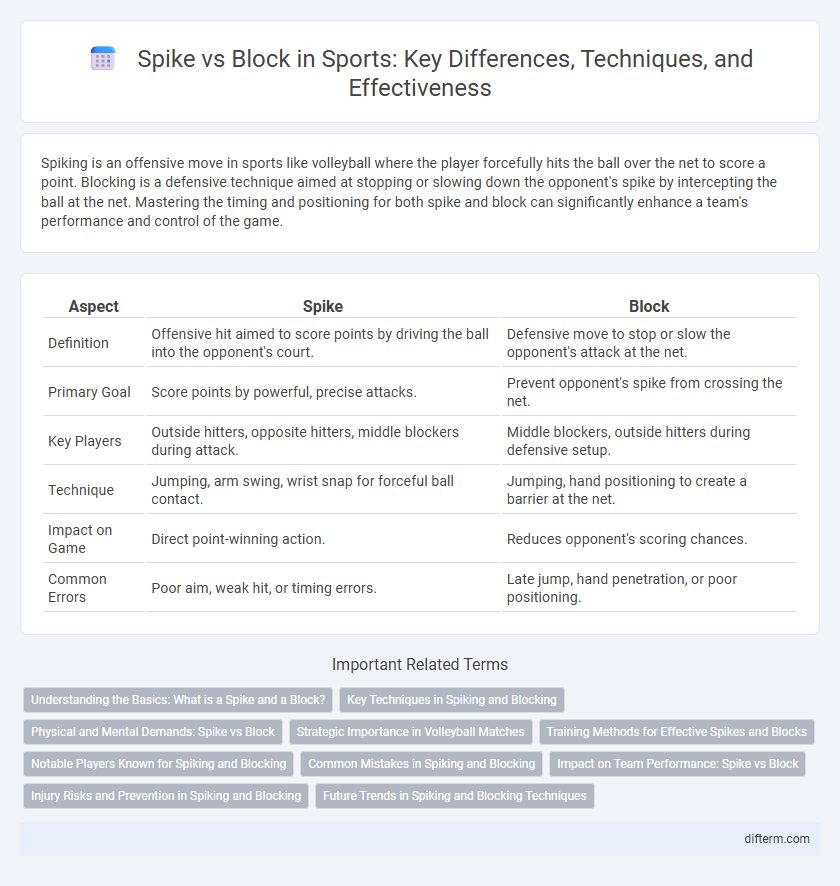Spiking is an offensive move in sports like volleyball where the player forcefully hits the ball over the net to score a point. Blocking is a defensive technique aimed at stopping or slowing down the opponent's spike by intercepting the ball at the net. Mastering the timing and positioning for both spike and block can significantly enhance a team's performance and control of the game.
Table of Comparison
| Aspect | Spike | Block |
|---|---|---|
| Definition | Offensive hit aimed to score points by driving the ball into the opponent's court. | Defensive move to stop or slow the opponent's attack at the net. |
| Primary Goal | Score points by powerful, precise attacks. | Prevent opponent's spike from crossing the net. |
| Key Players | Outside hitters, opposite hitters, middle blockers during attack. | Middle blockers, outside hitters during defensive setup. |
| Technique | Jumping, arm swing, wrist snap for forceful ball contact. | Jumping, hand positioning to create a barrier at the net. |
| Impact on Game | Direct point-winning action. | Reduces opponent's scoring chances. |
| Common Errors | Poor aim, weak hit, or timing errors. | Late jump, hand penetration, or poor positioning. |
Understanding the Basics: What is a Spike and a Block?
A spike in sports like volleyball is a forceful, downward hit aimed at scoring points by sending the ball over the net with speed and precision. A block is a defensive move where players jump near the net to intercept and prevent the opposing team's spike from crossing into their court. Mastering the timing and technique of both spike and block is essential for effective offense and defense during a match.
Key Techniques in Spiking and Blocking
Effective spiking relies on a full arm swing, wrist snap, and precise timing to generate maximum power and direct the ball sharply downward. Blocking requires strong hand positioning above the net, quick footwork, and anticipation to intercept the opponent's spike momentum. Mastery of these key techniques enhances offensive attacks and defensive stops in competitive volleyball.
Physical and Mental Demands: Spike vs Block
Spiking in volleyball demands explosive power, precise timing, and aggressive mental focus to outmaneuver defenders and score points. Blocking requires sharp reflexes, anticipatory skills, and intense concentration to read hitters and effectively intercept attacks. Both roles necessitate peak physical conditioning and mental resilience to perform under pressure during competitive play.
Strategic Importance in Volleyball Matches
A powerful spike forces the opposing team into a reactive defense, often leading to point-winning opportunities, while an effective block disrupts the opponent's attack rhythm and creates counterattack chances. Mastering the timing and positioning of spikes and blocks is crucial for controlling the net and dominating volleyball matches. Teams that strategically balance aggressive spikes with well-coordinated blocks increase their likelihood of winning critical rallies and overall games.
Training Methods for Effective Spikes and Blocks
Training methods for effective spikes emphasize plyometric exercises, upper body strength conditioning, and repetitive hitting drills to enhance power and accuracy. Block training focuses on footwork agility, timing drills, and core stability exercises to improve jump height and hand positioning. Incorporating video analysis and simulated game scenarios further refines technique and reaction speed for both spikes and blocks.
Notable Players Known for Spiking and Blocking
Notable volleyball players known for their spiking prowess include Karch Kiraly and Giba, whose powerful attacks revolutionized offensive play. On the defensive side, players like Jenia Grebennikov and Foluke Akinradewo are celebrated for their exceptional blocking skills, consistently shutting down opponents' spikes. The dynamic between these spike specialists and blockers highlights the strategic complexity and athleticism essential in competitive volleyball.
Common Mistakes in Spiking and Blocking
Common mistakes in spiking include poor timing, leading to ineffective attacks, and improper hand positioning that reduces power and control. In blocking, errors often involve failing to penetrate the net sufficiently and mistiming jumps, allowing the opposing spiker to bypass the block. Addressing these errors significantly improves offensive and defensive effectiveness in volleyball.
Impact on Team Performance: Spike vs Block
Spiking generates offensive pressure by consistently scoring points and disrupting the opponent's defense, boosting team momentum and confidence. Blocking serves as a critical defensive mechanism, limiting the opposing team's scoring opportunities and creating counterattack chances. Effective coordination of spikes and blocks significantly enhances overall team performance by balancing attack and defense dynamics.
Injury Risks and Prevention in Spiking and Blocking
Spiking in volleyball poses injury risks such as shoulder impingement, rotator cuff strains, and wrist sprains due to repetitive high-impact arm swings and forceful ball contact. Blocking carries risks including finger fractures, jammed fingers, and wrist hyperextension from sustained hand positioning and forceful ball deflections. Effective prevention strategies involve proper technique training, strength conditioning focusing on shoulder stability, and usage of protective taping or braces to minimize impact trauma.
Future Trends in Spiking and Blocking Techniques
Future trends in spiking emphasize the integration of advanced biomechanics and wearable technology to enhance power and precision. Blocking techniques are evolving through real-time data analysis and machine learning, allowing players to anticipate opponents' moves with greater accuracy. Innovations in training methodologies and sensor-based feedback systems are set to revolutionize both offensive and defensive skills in volleyball.
spike vs block Infographic

 difterm.com
difterm.com